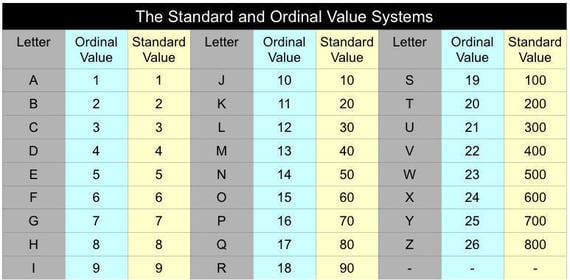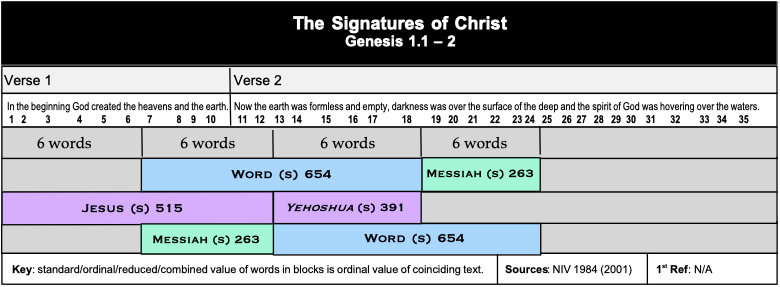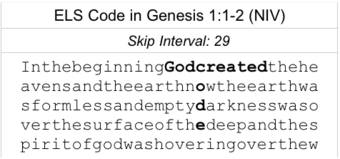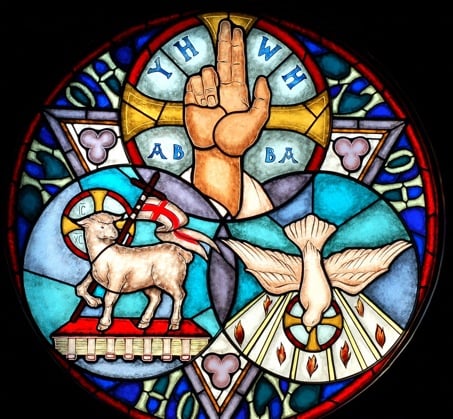The Signature of Christ

Introduction
If the millions of aficionados of Dan Brown’s The Da Vinci Code, are anything to go by, many people have a sizeable appetite for mystery. Mr. Brown’s best-seller is, of course, a work of fiction. Nevertheless, because he suggested that some of its premises may have a historical basis and that the Vatican may be suppressing this information, his book and the film made from it have generated feverish interest among sensation seekers in the possibility that Jesus may have had a wife and left a bloodline.
Now, for those adventurers whose appetite is not satisfied by fiction and speculation, I would like to present a very real mystery. What if someone found the signature of Jesus Christ? Moreover, what if this signature had been placed within a modern version of the Christian Bible, the NIV, [1] evidencing that Jesus had a hand in shaping it and that therefore he is in some way very much alive, just as Christians claim? What if there were in fact six such signatures, amounting to a kind of authenticating watermark on this version of the Bible? This is not fiction, nor is it in any way speculative. These are the conclusions to which I have come after years of revelation, research and discovery, as I slowly and painstakingly uncovered what appears to be a real bible code.
Letter Numerals and Gematria
Before I can show you the signatures I have to teach you the language in which they were written. It is a language in which words can be read as numbers and you are already familiar with the idea in Roman numerals. Seven letters from the Latin alphabet have been designated as numerals, representing numbers from 1 to 1000. [2] Under this scheme, any number can be represented as a string of these letter-numerals, the individual numerical values of the letters being summed or subtracted to give the desired total.
For example, the number 1160 can be represented by the letters MCLX,
MCLX = 1000 + 100 + 50 + 10 = 1160
Latin is not the only language in which letter-numerals were used for counting; this was also the case for Greek and Hebrew. According to a scheme first used in biblical times, the first nine letters of the Hebrew alphabet were assigned the values 1 to 9, the next nine letters took the values 10, 20, 30 . . . 90 and the last four took the values 100, 200, 300, 400. This was derived from an earlier Greek system, which was almost identical. [3] In written Hebrew and Greek, therefore, any number could be represented as the sum of a string of letter-numerals. [4]
Now words are also strings of letters, which means that words and phrases also can be assigned a numerical value. For instance, the Hebrew word transliterated as 'YHVH' (or 'Yahweh'), which means ‘The LORD’, has a value of 26, calculated as shown:
![]()
The study of correlations between the meanings carried by words, their numerical values and the inherent mathematical properties of these numbers is known as gematria. [5]
English language employed Arabic numerals to represent numbers and therefore had no need for letter numerals. Nevertheless, the Hebrew system of alphabetic numeration can still be applied to English letters. Under this scheme, A to I take the values 1 to 9, J to R take the values 10 to 90 and S to Z take the values 100 to 800. This yields a number I call the standard value of the word or phrase for which it is calculated. [6] This numeration system is one of four on which the code I have found is based. A second system is even simpler: the positional value of each letter of the alphabet becomes its numerical value. So the letters from A to Z take the values 1 to 26. This yields a number called the ordinal value.
The two keys are shown below.

Here is an example of how English words and phrases are numerated under the standard and ordinal value systems (identified by their initial letters in parenthesis):
| God (s) = 7 + 60 + 4 = 71 |
| God (o) = 7 + 15 + 4 = 26 |
Therefore, the standard value of the word ‘God’ is 71 and its ordinal value is 26. Note that the ordinal value of 'God' is the same as the standard and ordinal values of the Hebrew word 'YHVH', meaning 'the LORD'.
We now have enough information to decode the signatures, so let’s now turn to the first verses of the NIV Bible.
The Signatures
Each of the signatures are found only after the same decoding procedure is followed. This procedure has two steps:
1. A passage of text from the NIV Bible is converted into a number under the ordinal value system.
2. This is the standard value of a word or phrase, in this case a name or title for Jesus Christ.
An example will make things stunningly clear. Here are the first twelve words of the NIV, numerated under the ordinal value system.
1 In the beginning God created the heavens and the earth. 2 Now the ... (Gen. 1:1-2, NIV)
| Ist 12 words NIV Genesis (o) | = 515 |
| Jesus (s) | = 515 |
This is, I believe, the first signature of Christ. Notice that the signature is found within a block of twelve words. In the Bible the number twelve is associated with perfect government, which is why there were twelve tribes of Israel and why Jesus had twelve disciples. “One swallow does not a summer make.” said Aristotle. In similar vein, a sceptic could say: “One apparently meaningful connection does not a code make.” So let’s see if the next twelve words are also meaningful.
2 ... earth was formless and empty, darkness was over the surface of the ... (Gen. 1:2, NIV)
| Words 13 to 24 NIV Genesis (o) | = 654 |
| Word (s) | = 654 |
In the prologue of John we are told that “In the beginning was the word...”. John’s "Word" is of course a reference to Jesus Christ, known as the Word Incarnate, therefore this appears to be another signature.
If we bisect each of these twelve-word segments, further apparent signatures are revealed. Here are the first twenty-four words of the NIV Genesis, broken into six-word segments, with their ordinal values.
| In the beginning God created the (o) | = 252 |
| heavens and the earth. Now the (o) | = 263 |
| earth was formless and empty, darkness (o) | = 391 |
| was over the surface of the (o) | = 263 |
Now here are two words and their standard values: the English title ‘Messiah’ and the Hebrew word Yehoshua, which through Greek eventually became 'Jesus'.
Messiah (s) = 263
![]()
So three of these shorter segments also appear to contain signatures! Finally, if we sum the second and third numbers we again obtain 654, the standard value of ‘word’. So there appear to be six numerical signatures, forming a highly ordered pattern within the NIV Bible’s first twenty-four words. The signatures are displayed below.

‘Jesus’ and ‘Word’ Intertwined
In 2008 I discovered that the intertwined standard values of ‘Jesus’ and ‘Word’ run through the six signatures. ‘Jesus’ is the standard value of the even-numbered words within the first twenty-four words of the NIV, ‘Word’ the standard value of the odd-numbered words.
1 In the beginning God created the heavens and the earth. 2 Now the earth was formless and empty, darkness was over the surface of the ... (Genesis 1.1-2, NIV)
| Even words in 1st 24 of NIV Genesis (o) | = 515 |
| Jesus (s) | = 515 |
| Odd words in 1st 24 of NIV Genesis (o) | = 654 |
| Word (s) | = 654 |
This new phenomenon runs like golden braid through the signatures and further evidences that the NIV Bible’s opening words have been divinely woven. In conformance with the pattern of sixes and twelves associated with the signatures, each encoded number is found within twelve words. Therefore it appears that ‘Jesus’ and ‘Word’ are encoded in yet another way within the NIV Bible’s initial twenty-four words.
The code uses two further systems of alphabetic numeration to provide supplimentary information, making four systems in all, three of which are founded on long-accepted Hebrew systems. Under one, known as the reduced value, each letter takes the value 1 to 9.
The number of words within which this incredible phenomenon rests, 24, is the reduced value of Word, holy and Ihsous/Jesus! [7]
Winds of Chance?
Could the winds of chance have blown these numbers together?
Each of the encoded numbers is the standard value of a single word meaningfully related to Jesus Christ, so I picked seventy English words used the Bible for Jesus, such as 'Lord', 'Word', 'Friend', 'Comforter'. Then I worked out their standard values and did a binomial probability calculation to work out how many of these numbers should have been found in regular strings within the NIV's first twenty-four words. There should have been none, or perhaps one with a bit of luck. In reality there are five (I didn't include Yehoshua as it is Hebrew and including another language would complicate the calculations beyond my very limited capabilities). On average, this should have happened on only 1 in 1200 occasions.
The Signatures are the values of 'Jesus', 'Word' and 'Messiah', three of the list words most strongly linked to Jesus Christ. When the list is reduced to twenty names and titles, the odds against the signatures occurring by chance increase to 1 in 50000. 'Jesus', 'Word' and 'Messiah' would be very near the top of that list too. The real odds against the Signatures occurring by chance must be even higher, especially since 'Jesus', the first name on any such list, is the first name encoded by this method, since Yehoshua was not included in the calculations and since the phenomenon is meaningully linked to other encodings in the NIV and to the Genesis Creation story through the number six and the figure of Jesus Christ. I would say that a very conservative estimation of the real probability of the Signature phenomenon occuring by chance would be 1 in 100000, but it is surely much more improbable even than that.
Verification Of the Signatures Through An Equidistant-Letter-Sequence (ELS) Encoding
The New Bible Code is based primarily on gematria, the reading of words as numbers and numbers as words. This is in contrast to the well known Torah Codes, popularised by Michael Drosnin and others, which are based on equidistant letter sequences. In this type of code the letters of an encoded word or phrase are separated in the text by intervening letters, so they are undetectable to the reader. The separation, or skip interval, between the encoded letters is the same and if the text is broken up into segments of that number of letters and these placed under each other, the encoded information suddenly appears.
The search for ELS codes normally requires a computer programme. However, a simple manual search can also be undertaken if the skip intervals are small. This is what I have done with the opening few verses of the NIV bible, with the following result, obtained at a skip interval of 29.

Notice how the word ‘CODE’ intersects the plaintext words ‘GOD CREATED’. The skip interval of 29 is significant, as this is the reduced value of the word ‘Messiah’, the standard value of which is already found twice in this portion of text.
I discovered this apparent ELS encoding in about 2004 and at first I thought it might be coincidental. However, that was before I discovered the numerical signatures at the same location. On rechecking this phenomenon in April 2007, I noticed something truly astounding: the last letter of the word CODE is also the last letter of the NIV Bible’s first twenty-four words, the words within which the signatures themselves are found! In fact one letter is found within each group of six words, as shown below:

Therefore we have further evidence for the reality of this phenomenon [8], apparently encoded by an entirely independent method. This lends further credence to the idea that the signatures should be attributed to purposeful design, rather than random action.
Afterword
Could natural forces have produced such an elegant, highly ordered structure? Proponents of the chance hypothesis are confronted by an astounding confluence of unlikely features, each independent of the others, which combine to form this wonder:
a) There are six numerical signatures, found within the same tiny portion of text.
b) These signatures delineate four consecutive blocks of six words. If the signatures spanned variable numbers of words, or if they began or ended in the middle of words, or if they overlapped or were separated from each other, there would be far less inherent order and this phenomenon would be much less significant.
c) The number six, clearly woven into the structure of the signatures, is identified later as the number of days God took to complete His Creation. Six is also linked with man, made on the sixth day. Christ incarnated as a man.
d) Three signatures are associated with three of the six-word blocks, the other three are revealed by pairing adjacent blocks to form twelve-word blocks.
e) The signatures form three pairs: Jesus/Yehoshua, Messiah/Messiah, Word/Word. This pairing is a further layer of order on the signatures and contains the essence of the message that the entire code conveys.
f) The signatures are found at the very apex of the NIV Bible, and within words of immense theological import.
g) The words begin the biblical description of God’s creation of heaven and earth; the underlying signatures are of God Incarnate.
h) The signatures are all revealed by the same two-stage decoding process, employing two historically-established systems of alphabetic numeration adapted to the English alphabet.
In other words the signatures form a distinctive, eye-catching pattern, are found in the most significant location within all of Scripture—where they would be most likely to be discovered—and are meaningfully related to the subject matter of the text, despite the fact that the numeration process obliterates any meaning conveyed by the words. To find one of these features within the text, in isolation of the others, would be without significance, but in this instance they come together to form an integrated whole, characterised by order, harmony and meaning and in defiance of what must be astronomical odds against such an occurrence. Furthermore, as shown in other pages within this website, the first few verses of Genesis are the site of further coherent numerical patterns.
Therefore I draw the conclusion that, far from being explainable by random processes, these numerical signatures are clearly and magnificently the result of intelligent design. Moreover, the Designer has signed His work, so you are left in no doubt as to His identity. All that remains for us to know is why he signed this particular version of His Word, a mystery this website attempts to unravel.
Bill Downie 20/6/06
Latest update 1/10/12
Notes
1. New International Version Bible, 1984 Edition (2001 reprint), British English. The reader may be wondering why the NIV Bible was chosen as the repository for such a code. A clue as to the motives of whoever was responsible may be in the fact that the NIV is the most popular modern English translation of the Bible. In addition, English is now the international language of choice. If any bible and version were going to be encoded, it would be this one. Other English-language editions of the NIV also contain nearly all of the code, but the British-English version (1984 edition) contains it all, because it had to be finished before 9/11 occurred and because the author of this site, who was commisioned to find the code, lives in the UK.
2. The substitutions are as follows: I = 1, V = 5, X = 10, L = 50, C = 100, M = 1000. There are other numerals, but these are seldom used.
3. The Greek numeration system is called Ionian numerals.
4. Unlike the Roman system, where letter numerals can be subtracted, the Greek and Hebrew systems are purely additive.
5. Gematria, the art of discerning meaningful numerical patterns within languages, is primarily associated with the study of the Greek and Hebrew scriptures. Opinion is divided over whether gematria should be applied more widely, although I hope this website will convince enquirers that this is most certainly the case.
6. As far as I am aware, the first person to apply the Hebrew system of numeration to the English language was the retired Welsh mathematics lecturer Vernon Jenkins, although others may have preceded him.
7. The reduced value system of numeration is the reduction of the standard value to a single digit. So Z would have a reduced value of 8 + 0 + 0 = 8. All three substitution schemes - standard, ordinal and reduced - are used in Hebrew gematria.
8. This is also supporting evidence for the reality of the well-known Torah codes.
